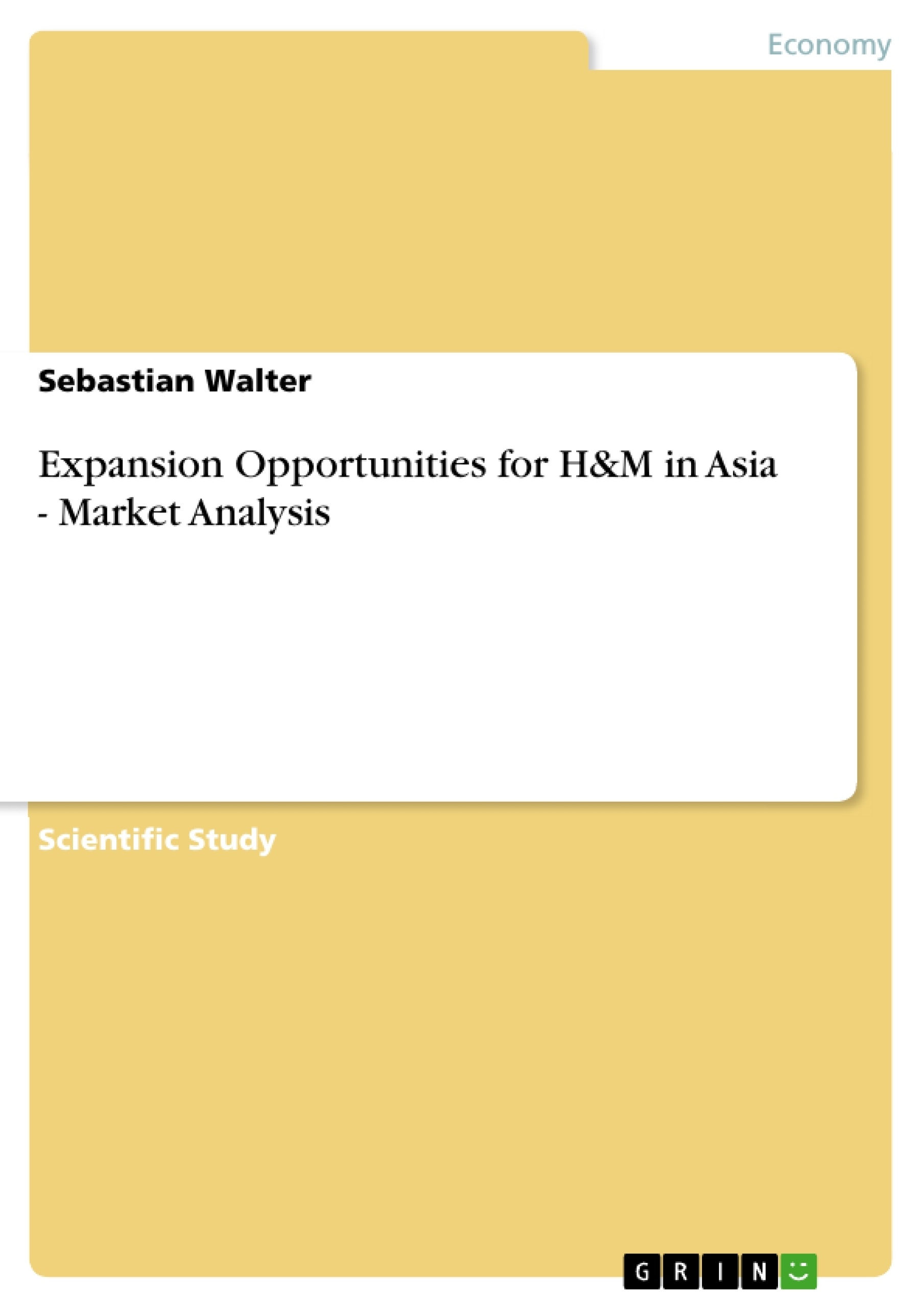Excerpt
TABLE OF CONTENTS
INTRODUCTION
THE BUSINESS MODEL
EXTERNAL ANALYSIS
Initial Screening
Financial & Economic Forces
Japan
South Korea
Political & Legal Forces
Japan
South Korea
Socio-cultural Forces
Japan
South Korea
Market Forces
Japan
Demand Analysis
Competitive Analysis
South Korea
Demand Analysis
Competitive Analysis
Final Selection
RECOMMENDATION
APPENDICES
END NOTES
REFERENCE LIST
INTRODUCTION
Hennes & Mauritz (H&M) is a Europe’s second-largest clothing retailer. Founded 1946 by Erling Persson in Sweden, H&M initially sold women clothing through “Hennes” stores in Sweden. “Hennes” is Swedish and means “for her”. In 1968 the company acquired the hunting apparel retailer Mauritz Widforss , which also offered collections for men, and changed its name into Hennes & Mauritz.
Today H&M offers clothes, own-brand cosmetics, accessories and footwear in over 1,800 stores in 34 countries around the world. H&M employs around 73,000 people and achieved a turnover of SEK 104,041 million in 2008 (H&M, 2008). H&M’s extensive product line can be broadly categorized into: women, teenagers, men, children, accessories and cosmetics.
H&M strives for constant expansion targeting 10-15% growth of store numbers annually to leverage its core competencies. 214 stores were added in 2008 and 225 new stores are planned to be added globally in 2009. In exceptional cases like the Middle East and Kuwait, H&M has entered through franchise operations. However, wholly-owned subsidiaries are the preferred mode of entry to keep full organizational control of foreign subsidiaries (H&M, 2008).
This study aims to identify a market that suits H&M’s successful business model and offers an attractive opportunity-risk relation. For this purpose we firstly need to understand the business model and core competencies of H&M. Secondly, two alternative markets are selected for a country screening process. Thirdly, risks and opportunities inherent to their economic, political & legal, socio-cultural, and market forces are assessed and finally a recommendation under consideration of key success factors is made.
THE BUSINESS MODEL
H&M is the pioneer of ‘fast-fashion’: “a term used to describe clothing collections based on the most recent trends on the catwalk, but designed and manufactured quickly, affordable, and aimed at mainstream consumers” (Research and Markets, 2006). This market-segment is mainly driven by cost pressures due to its lower-income target group which purchases fashion at a high frequency.
In order to achieve cost efficiencies, H&M outsources the labour-intense production of its products to independent manufacturers in countries like China and Turkey. Location economies that arise from those countries’ endowment of cheap labour are realized this way. Production orders are placed in large scale through 21 wholly-owned production offices to avoid the costs of middlemen (H&M, 2009). Short-term supplier contracts increase H&M’s responsiveness to changes of sourcing conditions and allow constantly sourcing at the lowest price available (H&M 2008a).
Distinctive value-adding core competencies are centralized at the head quarters in Stockholm. For example, collections are designed by around 100 in-house designers, guidelines for store interior designs globally are developed, and over 100 merchandisers structure the product ranges offered in the stores world-wide in Stockholm (Goeransson, Joensson, Persson, 2007; H&M 2009). Outsourcing of production expertise allowed H&M to focus on in-depth knowledge about design, fashion and textiles and thus to lower costs of value creation over time. Hill, Jones, Galvin, & Haidar (2007) refer to this as experience curve effects.
The global strategy employed by H&M matches their business-level strategy expressed through the mission statement: “offering fashion and quality at the best price”. Porter (1998) refers to this as Cost Leadership Strategy.
H&M’s constantly strengthens its market position through innovation and change. Globally, stores are refreshed with new fashion items on a daily basis. Key store element’s like windows are changed every 10 – 14 days and every three years a completely new interior design is implemented for stores in key markets (H&M, 2008). Those constant changes combined with its high-street locations ensure H&M the steady flow of customers that is crucial to the success of its business model.
In order to cope with high coordination requirements, H&M is organized in a functional – regional matrix structure (see Exhibit 1). Group functions are centralized at the head quarters with executive managers held responsible for the performance of all countries within their function. On the other side, country managers are responsible for the profitability of their country and therefore for all functions within a country. This allows H&M to draw from functional expertise on the one, and country specific knowledge on the other side to cope with the low but existing requirements for local responsiveness.
[...]
- Quote paper
- Bachelor of Science Sebastian Walter (Author), 2009, Expansion Opportunities for H&M in Asia - Market Analysis, Munich, GRIN Verlag, https://www.grin.com/document/140245
Publish now - it's free























Comments